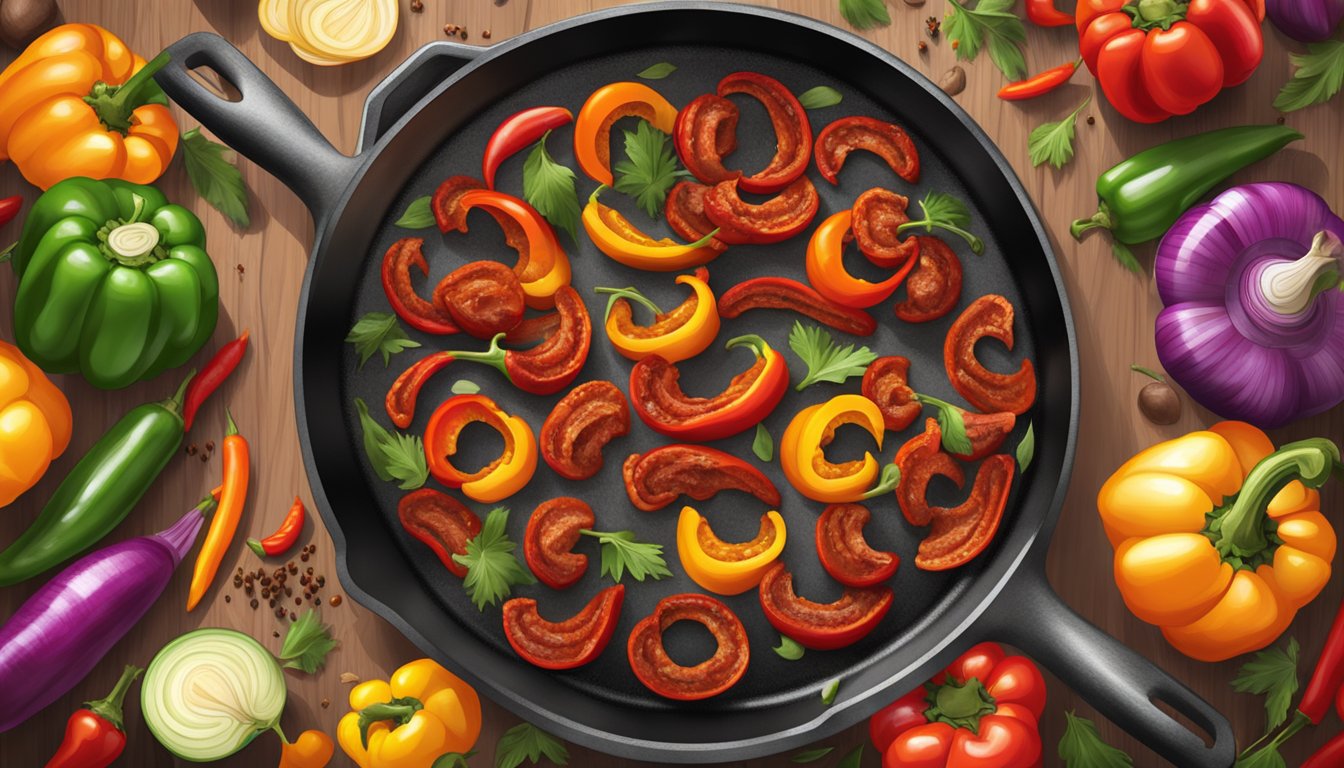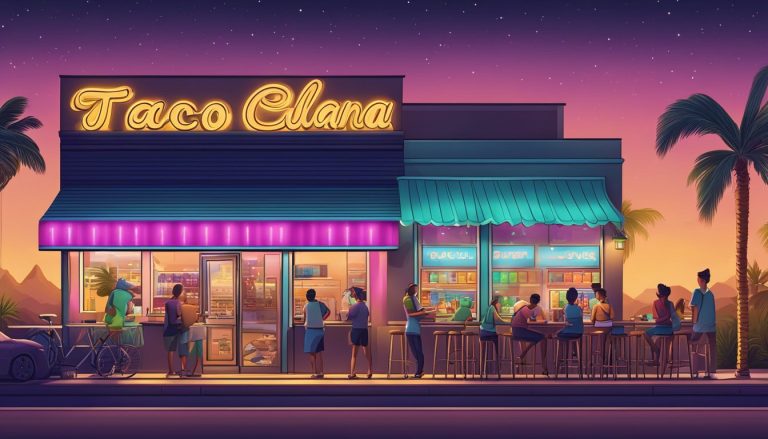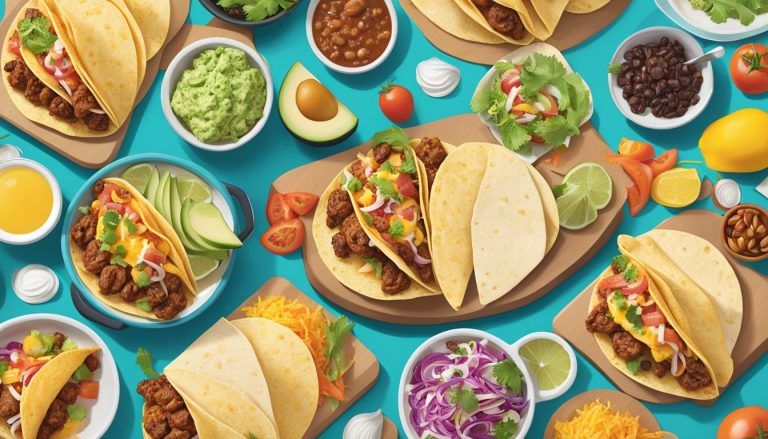Taco Cabana, a beloved Tex-Mex fast-food chain, has been serving up delicious tacos and other Mexican-inspired dishes since 1978. Founded by Felix Stehling in San Antonio, Texas, the restaurant quickly became known for its fresh ingredients and authentic flavors.
While Taco Cabana’s menu has evolved over the years, one item that has remained a staple is chorizo. This spicy sausage has been a key ingredient in many of Taco Cabana’s popular dishes since the early days of the restaurant. The chain’s commitment to using high-quality chorizo has helped solidify its reputation as a go-to spot for authentic Tex-Mex cuisine.
Taco Cabana’s use of chorizo reflects the deep culinary traditions of San Antonio and the surrounding region. The restaurant’s founders recognized the importance of incorporating local flavors and ingredients into their menu, helping to create a unique dining experience that has kept customers coming back for decades.
Origins of Taco Cabana

Taco Cabana’s roots trace back to a single location in San Antonio, Texas. The restaurant’s founding story highlights entrepreneurial ingenuity and a unique open-air concept that set it apart from other fast-food establishments.
The Founding Story
Felix Stehling opened the first Taco Cabana in September 1978. He purchased a vacant Dairy Queen building at the corner of San Pedro and Hildebrand Avenue in Midtown San Antonio. Stehling’s initial motivation was pragmatic – he needed additional parking for his bar, the Crystal Pistol, located across the street.
Recognizing an opportunity, Stehling decided to transform the space into a taco stand. The existing structure’s open-air design became a defining feature of Taco Cabana’s identity.
The Significance of the First Location
The original Taco Cabana site quickly gained popularity among locals. Its 24-hour service and patio-style dining created a unique atmosphere that differentiated it from traditional fast-food chains.
The restaurant’s success at this location led to its expansion. The open-air concept, born from the first restaurant’s structure, became a signature element of Taco Cabana’s brand identity. This initial site laid the foundation for what would become a successful Tex-Mex restaurant chain across multiple states.
Menu Evolution and Tex-Mex Cuisine

Taco Cabana’s menu has undergone significant changes over the years, reflecting the evolving tastes of Tex-Mex cuisine enthusiasts. The introduction of chorizo and other traditional Mexican ingredients has played a crucial role in shaping the restaurant’s identity.
Incorporating Tex-Mex Flavors
Taco Cabana embraced Tex-Mex cuisine early on, blending traditional Mexican flavors with American tastes. The restaurant’s signature house-made tortillas became the foundation for many popular menu items. Tacos, quesadillas, and enchiladas showcased the unique Tex-Mex style that has become synonymous with the brand.
Fajitas emerged as a standout dish, combining grilled meats with peppers and onions. This sizzling platter quickly became a customer favorite, embodying the essence of Tex-Mex cuisine.
The Introduction of Chorizo
Chorizo made its debut on Taco Cabana’s menu as part of the breakfast offerings. The spicy sausage found a natural home in breakfast tacos, pairing perfectly with eggs and cheese. This combination proved immensely popular among patrons seeking hearty morning meals.
The chorizo’s success led to its incorporation in other menu items. Taco Cabana sources high-quality chorizo, ensuring authentic flavors that resonate with Tex-Mex enthusiasts.
Expanding the Menu
As Taco Cabana grew, so did its menu. The restaurant introduced a variety of new dishes to cater to diverse palates. Platters featuring rice, beans, and meat options offered customers complete meal experiences.
The drink menu expanded to include margaritas and beer, enhancing the dining experience. These alcoholic beverages complemented the spicy and savory flavors of the food menu.
Taco Cabana’s 24-hour drive-thru service became a key feature, allowing customers to enjoy Tex-Mex cuisine at any time of day or night.
Business Expansion and Franchising

Taco Cabana’s growth trajectory has been marked by strategic expansion and a recent shift towards franchising. The company has steadily increased its presence in Texas while eyeing opportunities in neighboring states.
Early Growth and Development
Taco Cabana began its journey in San Antonio, Texas in 1978. The chain quickly gained popularity for its Tex-Mex offerings and drive-thru convenience. By the early 1980s, Taco Cabana had established a strong foothold in San Antonio.
The company’s expansion initially focused on major Texas cities. Houston became a key market, with multiple locations opening throughout the 1980s and 1990s. This targeted growth strategy allowed Taco Cabana to refine its operations and build brand recognition within the state.
Entering New Markets
As Taco Cabana solidified its Texas presence, the company began exploring opportunities beyond state lines. New Mexico and Oklahoma were among the first out-of-state markets targeted for expansion.
These moves allowed Taco Cabana to test its concept in new regions while remaining close to its core Texas market. The company’s menu, featuring breakfast tacos, street tacos, and margaritas, resonated with customers in these neighboring states.
The Franchise Model
In 2024, Taco Cabana launched its franchise program, marking a significant shift in its growth strategy. This move aims to accelerate expansion into new markets, including Arizona, Arkansas, Colorado, and Missouri.
The franchise model was developed with input from experienced franchisees, ensuring it addresses key operator concerns. Taco Cabana’s franchise offerings include:
- Drive-thru equipped locations
- Diverse menu options
- Value-focused items under $5
With over 140 existing locations, Taco Cabana seeks to leverage its brand recognition and operational expertise to attract franchise partners. This new approach positions the company for potential nationwide growth as it approaches its 50th anniversary.
Corporate Developments

Taco Cabana underwent significant changes in ownership and corporate structure over the years. These shifts impacted the company’s growth strategies and market position.
Stock Offerings and Ownership Changes
Taco Cabana went public in 1992, offering stock to raise capital for expansion. The company’s headquarters remained in San Antonio, Texas. In 2000, Carrols Corporation acquired Taco Cabana, integrating it into their portfolio of quick-service restaurant brands.
Fiesta Restaurant Group later spun off from Carrols, becoming Taco Cabana’s parent company. This move allowed for more focused management of the Tex-Mex chain alongside its sister brand, Pollo Tropical.
In 2021, YTC Enterprises purchased Taco Cabana from Fiesta Restaurant Group for $85 million. The acquisition marked a return to Texas-based ownership for the chain.
Strategic Partnerships and Acquisitions
Taco Cabana’s corporate strategy included forming partnerships to enhance its market presence. The company collaborated with food suppliers to maintain quality standards for its signature dishes, including chorizo.
Taco Cabana also pursued smaller acquisitions to strengthen its position in key markets. These targeted purchases helped the chain expand its footprint in Texas and neighboring states.
The company explored co-branding opportunities with complementary businesses. These partnerships aimed to increase foot traffic and introduce Taco Cabana to new customer segments.
Dining Experience and Restaurant Ambiance

Taco Cabana’s unique dining atmosphere and round-the-clock service set it apart in the fast-casual Mexican restaurant landscape. The chain’s signature patio cafes and extensive breakfast offerings create a welcoming environment for guests at any time of day.
The Signature Patio Cafes
Taco Cabana pioneered the concept of “patio cafes” in the fast-casual dining sector. These semi-enclosed patio dining areas feature festive Mexican-inspired decor, creating a vibrant and inviting atmosphere.
The patios are equipped with comfortable furniture, allowing guests to enjoy their meals in a relaxed outdoor setting. Colorful umbrellas and string lights add to the ambiance, especially during evening hours.
This unique dining environment helps Taco Cabana stand out from typical fast-food establishments. The patio cafes blend the convenience of quick-service with the pleasant atmosphere of a sit-down restaurant.
24-Hour Service and Breakfast Offerings
Many Taco Cabana locations operate 24 hours a day, catering to late-night diners and early risers alike. This round-the-clock service is particularly popular among shift workers and night owls seeking fresh, made-to-order meals at unconventional hours.
The chain’s breakfast menu is a key component of its all-day offerings. Breakfast tacos, a staple of Tex-Mex cuisine, are available throughout the day. Popular options include:
- Bean and cheese tacos
- Bacon and egg tacos
- Chorizo and potato tacos
Taco Cabana’s commitment to serving breakfast at any hour aligns with its goal of providing convenient, quality food to customers regardless of their schedules.
Marketing and Customer Engagement
Taco Cabana employs diverse strategies to attract and retain customers. The company focuses on promotions, happy hours, and e-commerce initiatives to boost sales and foster brand loyalty.
Promotions and Happy Hours
Taco Cabana offers regular promotions to entice customers. Daily specials feature discounted menu items, encouraging repeat visits. The chain’s happy hour, typically from 4-7 PM, provides reduced prices on margaritas and select appetizers.
Seasonal promotions align with holidays and events. During Cinco de Mayo, Taco Cabana runs week-long deals on tacos and Mexican-inspired beverages. The company also introduces limited-time menu items to spark interest and drive traffic.
Social media plays a crucial role in promoting these offers. Taco Cabana uses platforms like Facebook and Instagram to announce deals and engage with customers directly.
Leveraging E-commerce with TCGear.com
TCGear.com serves as Taco Cabana’s online merchandise store. Launched in 2018, the site offers branded apparel, accessories, and gift cards.
Popular items include t-shirts featuring Taco Cabana’s logo and slogans. The store also sells novelty items like hot sauce-themed socks and taco-shaped stress balls.
TCGear.com helps extend brand reach beyond restaurant walls. It allows fans to show their loyalty and serves as an additional revenue stream for the company.
The site runs periodic sales, often coinciding with in-restaurant promotions. This strategy creates a cohesive marketing approach across both physical and digital channels.
Innovation in Service and Quality

Taco Cabana revolutionized its approach to service and food quality, embracing a fast casual model while prioritizing freshness and customization. These changes positioned the brand as a leader in the Mexican grill segment.
Transition to a Fast Casual Restaurant
Taco Cabana evolved from a traditional quick-service restaurant to a fast casual concept. This shift allowed for a more upscale dining experience while maintaining efficient service. The restaurant redesigned its interiors, creating a welcoming atmosphere with vibrant colors and modern decor.
Customers now enjoy a hybrid model that combines counter ordering with table service. This approach reduces wait times while providing a more personalized experience. The transition also introduced digital ordering kiosks and a mobile app, streamlining the ordering process for tech-savvy diners.
Commitment to Fresh Foods and Made-to-Order
Taco Cabana doubled down on its commitment to quality by emphasizing fresh, made-to-order meals. The restaurant installed open kitchens, allowing customers to watch their food being prepared. This transparency builds trust and showcases the use of fresh ingredients.
The menu expanded to include customizable options, letting diners tailor their meals to their preferences. Taco Cabana sources local produce when possible, ensuring peak freshness and supporting regional farmers. The restaurant also introduced a daily prep system, with ingredients prepared in small batches throughout the day to maintain quality and reduce waste.
Legal Challenges and Industry Disputes

Taco Cabana faced significant legal battles to protect its unique restaurant concept and trade dress. The most notable case reached the highest court in the United States, setting an important precedent in trademark law.
Two Pesos vs. Taco Cabana Supreme Court Case
In 1987, Taco Cabana filed a lawsuit against Two Pesos for trade dress infringement under the Lanham Act. Two Pesos had opened restaurants with a similar atmosphere and decor to Taco Cabana’s distinctive style. The case made its way to the Supreme Court in 1992.
The key issue was whether Taco Cabana’s trade dress could be protected without proving secondary meaning. The Court ruled in Taco Cabana’s favor, stating that inherently distinctive trade dress can be protected under the Lanham Act without showing secondary meaning.
This landmark decision expanded trademark protection for businesses. It allowed companies to safeguard their unique visual presentations and concepts more easily, even without widespread public recognition.
The ruling had significant implications for the restaurant industry. It emphasized the importance of developing distinctive visual branding and restaurant atmospheres. The case also highlighted the need for businesses to be cautious when adopting design elements similar to competitors.
Financial Performance and Pricing Strategies

Taco Cabana’s financial trajectory has been shaped by strategic pricing decisions and diverse revenue streams. The company has balanced value offerings with premium items to drive growth.
Evolving Revenue Streams
Taco Cabana has diversified its revenue sources beyond traditional dine-in sales. Drive-thru service became a significant contributor, accounting for a substantial portion of total revenue. The company expanded into catering and group meal packages, tapping into new market segments.
Online ordering and delivery partnerships emerged as crucial revenue channels, especially during economic shifts. Taco Cabana also introduced branded merchandise and packaged goods, creating additional income streams.
Pricing Models and Value Perception
Taco Cabana implemented a tiered pricing strategy to appeal to various customer segments. Value menus targeted budget-conscious diners, while premium items catered to those seeking higher-end options.
The company utilized dynamic pricing during peak hours and special events. This approach optimized revenue during high-demand periods. Taco Cabana also introduced combo meals and family packs, enhancing perceived value for customers.
Loyalty programs and targeted promotions were employed to drive repeat business and increase average transaction values. The company regularly analyzed pricing elasticity to maintain competitiveness while preserving profit margins.
Impact on the Restaurant Industry

Taco Cabana’s innovative approach to Mexican fast-casual dining left a significant mark on the restaurant industry. The chain’s unique offerings and business model influenced competitors and collaborators alike.
Influencing the Fast Casual Segment
Taco Cabana pioneered the fast-casual Mexican food concept, bridging the gap between fast food and sit-down restaurants. The chain’s focus on fresh ingredients and made-to-order meals set a new standard in the industry. Competitors soon adopted similar models, leading to a surge in fast-casual Mexican restaurants across the United States.
Taco Cabana’s 24-hour operations and drive-thru service also became industry benchmarks. These features appealed to customers seeking convenience without sacrificing quality, prompting other chains to extend their hours and improve their drive-thru efficiency.
Collaboration with Other Industry Players
Taco Cabana’s success attracted attention from major players in the restaurant industry. The chain partnered with House of Blues to create themed menu items, showcasing the potential for cross-brand collaborations in the fast-casual sector.
This partnership demonstrated how restaurants could leverage cultural connections to enhance their offerings and appeal to broader audiences. Other chains followed suit, exploring similar collaborations to differentiate themselves in a competitive market.
Taco Cabana’s influence extended beyond menu innovations. Its open-air patio design became a signature feature, inspiring other restaurants to incorporate outdoor seating areas. This trend reshaped the physical layout of many fast-casual establishments, enhancing the dining experience for customers.
Leveraging Brand Heritage and Customer Loyalty

Taco Cabana’s chorizo journey reflects its commitment to authentic Mexican flavors and customer preferences. The restaurant chain has skillfully balanced tradition with innovation to maintain relevance and build lasting relationships.
Brand Evolution and Identity
Taco Cabana, founded in San Antonio in 1978, has embraced its Tex-Mex roots while adapting to changing tastes. The introduction of chorizo to its menu exemplifies this approach. The spicy sausage, a staple in Mexican cuisine, became a signature offering that set Taco Cabana apart from competitors.
YTC Enterprises LLC, the parent company, has strategically positioned chorizo as a key element of Taco Cabana’s brand identity. This move reinforced the chain’s authenticity and appeal to both traditionalists and adventurous diners.
Fostering Long-Term Customer Relationships
Taco Cabana’s consistent quality and innovation with chorizo have cultivated a loyal customer base. The chain regularly introduces new chorizo-based dishes, keeping the menu fresh and exciting. This strategy encourages repeat visits and word-of-mouth recommendations.
Customer feedback has played a crucial role in shaping Taco Cabana’s chorizo offerings. The company actively solicits input through surveys and social media, demonstrating its commitment to meeting customer preferences. This responsive approach has strengthened the emotional connection between the brand and its patrons, fostering long-term loyalty.




